Exchanging Ideas and Specimens
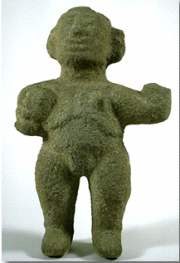
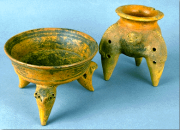 International exchange has always been a major part of the Smithsonian's mission. To acquire publications from leading scientific societies, Secretary Henry offered in exchange the journal, Smithsonian Contributions to Knowledge. Henry and assistant secretary Baird also distributed publications from U.S. colleges, museums, scientific societies, and scientists to their counterparts abroad. The International Exchange Service, founded in 1849, dealt with Latin American distribution agents such as Museo Publico, Buenos Aires; the Commission of International Exchange, Rio de Janeiro; Sociedad Económica de Amigos del País, Guatemala City; Museo Nacional, Mexico City; and Secretaire d'etat des Relations Exterieures, Port-au-Prince.
International exchange has always been a major part of the Smithsonian's mission. To acquire publications from leading scientific societies, Secretary Henry offered in exchange the journal, Smithsonian Contributions to Knowledge. Henry and assistant secretary Baird also distributed publications from U.S. colleges, museums, scientific societies, and scientists to their counterparts abroad. The International Exchange Service, founded in 1849, dealt with Latin American distribution agents such as Museo Publico, Buenos Aires; the Commission of International Exchange, Rio de Janeiro; Sociedad Económica de Amigos del País, Guatemala City; Museo Nacional, Mexico City; and Secretaire d'etat des Relations Exterieures, Port-au-Prince.
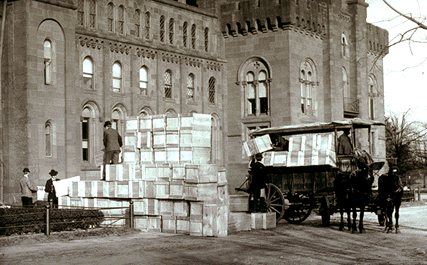
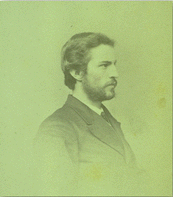 Soon there were other items available for exchange as well, such as this Precolumbian figure sent by José Zeledón of Costa Rica. When the U.S. Congress appointed the Smithsonian as "curator of government collections" in 1858, Baird examined the enormous hoard at the U.S. Patent Office. "No country has better collections of so large an area," he wrote. Realizing that trade would expand the collection, he suggested that "duplicate specimens should be distributed among other American museums."
Soon there were other items available for exchange as well, such as this Precolumbian figure sent by José Zeledón of Costa Rica. When the U.S. Congress appointed the Smithsonian as "curator of government collections" in 1858, Baird examined the enormous hoard at the U.S. Patent Office. "No country has better collections of so large an area," he wrote. Realizing that trade would expand the collection, he suggested that "duplicate specimens should be distributed among other American museums."
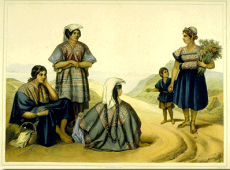
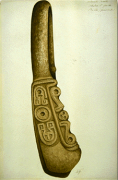 These trading programs were remarkably successful. By 1881 the International Exchange Service had shipped over 1,054,000 pounds of publications abroad, and had received over 260,000 individual items and packages of books to forward to U.S. institutions. Among the materials received were volumes such as Don Carlos Nebel's beautifully illustrated Viaje pintoresco y arqueológico sobre la parte más interesante de la República Mejicana. In an 1857 letter to William C. Bond, Director of the Harvard Observatory, Professor Charles Moesta of the University of Chile wrote: "I understand that a box with books from that Institution [the Smithsonian] has arrived lately at Valparaiso and is expected here every day. This is indeed, as far as I know, the only safe and easy way of transmitting packages."
These trading programs were remarkably successful. By 1881 the International Exchange Service had shipped over 1,054,000 pounds of publications abroad, and had received over 260,000 individual items and packages of books to forward to U.S. institutions. Among the materials received were volumes such as Don Carlos Nebel's beautifully illustrated Viaje pintoresco y arqueológico sobre la parte más interesante de la República Mejicana. In an 1857 letter to William C. Bond, Director of the Harvard Observatory, Professor Charles Moesta of the University of Chile wrote: "I understand that a box with books from that Institution [the Smithsonian] has arrived lately at Valparaiso and is expected here every day. This is indeed, as far as I know, the only safe and easy way of transmitting packages."
The Institution dispersed many objects from its collections to museums, schools, libraries, and private collections in North, Central and South America. One of the Smithsonian's exchange partners was Louis Guesde, an artist and zealous collector of Carib and Taino antiquities. He donated an album of watercolors, illustrating a rare carved wooden chair, a beautiful stone yoke, and other objects from his celebrated collection.
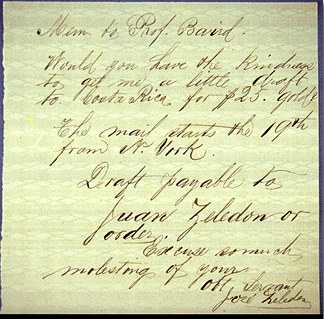
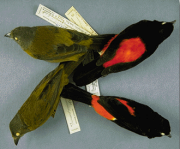
 Since the late 1850s, the Anthropology Department alone has exchanged more than 13,000 ethnographic objects and 40,000 archaeological artifacts with more than 400 institutions worldwide, many in Latin America. Similar exchanges were conducted by the departments of geology, botany, fishes, and mammals, often through checklists distributed among institutions or collectors. The Costa Rican ornithologist José Zeledén, in his correspondence with Spencer Baird, documents numerous trades, including archaeological materials and the birds of the region. Today the exchange of museum objects still advances the study of natural environments in the Americas.
Since the late 1850s, the Anthropology Department alone has exchanged more than 13,000 ethnographic objects and 40,000 archaeological artifacts with more than 400 institutions worldwide, many in Latin America. Similar exchanges were conducted by the departments of geology, botany, fishes, and mammals, often through checklists distributed among institutions or collectors. The Costa Rican ornithologist José Zeledén, in his correspondence with Spencer Baird, documents numerous trades, including archaeological materials and the birds of the region. Today the exchange of museum objects still advances the study of natural environments in the Americas.
